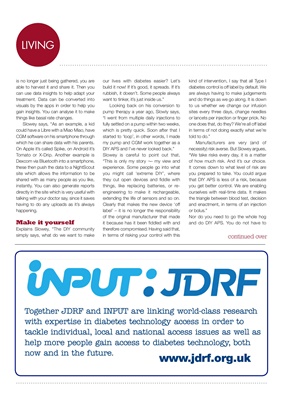
LIVINGLIVING
Together JDRF and INPUT are linking world-class research
with expertise in diabetes technology access in order to
tackle individual, local and national access issues as well as
help more people gain access to diabetes technology, both
now and in the future.
www.jdrf.org.uk
intervention, I say that all Type I diabetes
control is off label by default. We are
always having to make judgements and
do things as we go along. It is down to
us whether we change our infusion sites
every three days, change or needles or
lancets per injection or finger prick. No
one does that, do they? We're all off label
in terms of not doing exactly what we're
told to do."
Manufacturers are very (and of
necessity) risk averse. But Slowey argues,
"We take risks every day, it is a matter
of how much risk. And it's our choice.
It comes down to what level of risk are
you prepared to take. You could argue
that DIY APS is less of a risk, because
you get better control. We are enabling
ourselves with real-time data. It makes
the triangle between blood test, decision
and enactment, in terms of an injection
or bolus."
Nor do you need to go the whole hog
and do DIY APS. You do not have to
our lives with diabetes easier? Let's
build it now! If it's good, it spreads. If it's
rubbish, it doesn't. Some people always
want to tinker, it's just inside us."
Looking back on his conversion to
pump therapy a year ago, Slowly says,
"I went from multiple daily injections to
fully settled on a pump within two weeks,
which is pretty quick. Soon after that I
started to 'loop', in other words, I made
my pump and CGM work together as a
DIY APS and I've never looked back."
Slowey is careful to point out that,
"This is only my story ¬- my view and
experience. Some people go into what
you might call 'extreme DIY', where they
cut open devices and fiddle with things,
like replacing batteries, or re-engineering
to make it rechargeable, extending the
life of sensors and so on. Clearly that
makes the new device 'off label' - it is
no longer the responsibility of the original
manufacturer that made it because
has been fiddled with and therefore
compromised. Having said that, in terms
of risking your control with this kind of
is no longer just been gathered, you are
able to harvest it and share it. Then you
can use data insights to help adapt your
treatment. Data can be converted into
visuals by the apps in order to help you
gain insights. You can analyse it to make
things like basal rate changes.
Slowey says, "As an example, a kid
could have a Libre with a Miao Miao, have
CGM software on his smartphone through
which he can share data with his parents.
On Apple it's called Spike, on Android it's
Tomato or X-Drip. Another example is
Dexcom via Bluetooth into a smartphone,
these then push the data to a NightScout
site which allows the information to be
shared with as many people as you like,
instantly. You can also generate reports
directly in the site which is very useful with
talking with your doctor say, since it saves
having to do any uploads as it's always
happening.
Make it yourself
Explains Slowey, "The DIY community
simply says, what do we want to make continued over